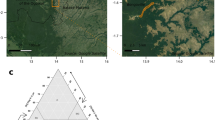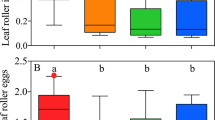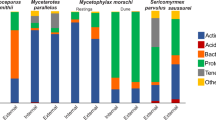Abstract
Many epiphytic plants have associated with ants to gain nutrients. Here, we report a novel type of ant–plant symbiosis in Fiji where one ant species actively and exclusively plants the seeds and fertilizes the seedlings of six species of Squamellaria (Rubiaceae). Comparison with related facultative ant plants suggests that such farming plays a key role in mutualism stability by mitigating the critical re-establishment step.
This is a preview of subscription content, access via your institution
Access options
Subscribe to this journal
Receive 12 digital issues and online access to articles
$119.00 per year
only $9.92 per issue
Buy this article
- Purchase on Springer Link
- Instant access to full article PDF
Prices may be subject to local taxes which are calculated during checkout


Similar content being viewed by others
References
Brock, D. A., Douglas, T. E., Queller, D. C. & Strassmann, J. E. Nature 469, 393–396 (2011).
Thurber, A. R., Jones, W. J. & Schnabel, K. PLoS ONE 6, e26243 (2011).
Pauli, J. N. et al. Proc. R. Soc. B 281, 20133006 (2014).
Mueller, U. G., Gerardo, N. M., Aanen, D. K., Six, D. L. & Schultz, T. R. Ann. Rev. Ecol. Evol. Syst. 36, 563–595 (2005).
Chomicki, G. & Renner, S. S. New Phytol. 207, 411–424 (2015).
Davidson, D. W. Ecology 69, 1138–1152 (1988).
Davidson, D. W. & Epstein, W. W. in Vascular plants as epiphytes (ed. Lüttge, U.) 200–233 (Springer, Berlin Heidelberg, 1989).
Huxley, C. R. New Phytol. 80, 231–268 (1978).
Rico-Gray, V., Barber, J. T., Thien, L. B., Ellgaard, E. G. & Toney, J. J. Am. J. Bot. 76, 603–608 (1989).
Treseder, K. K., Davidson, D. W. & Ehleringer, J. R. Nature 375, 137–139 (1995).
Laube, S. & Zotz, G. Funct. Ecol. 17, 598–604 (2003).
Chomicki, G. & Renner, S. S. PLoS ONE 11, e0151317 (2016).
Chomicki, G., Staedler, Y. M., Schönenberger, J. & Renner, S. S. New Phytol. 211, 1358–1370 (2016).
Youngsteadt, E., Nojima, S., Häberlein, C., Schulz, S. & Schal, C. Proc. Natl Acad. Sci. USA 105, 4571–4575 (2008).
Kaufmann, E. & Maschwitz, U. Naturwissenschaften 93, 216–227 (2006).
Ivens, A. B. F. Myrmecol. News 21, 19–36 (2015).
Acknowledgements
We thank J. Aroles for essential help in the field and critical reading of the manuscript; A. Naikatini and M. Tuiwava for help with permissions and voucher collection; V. Mayer, University of Vienna, for instructions and material for the nitrogen isotope experiments; C. Mayr, University of Munich, for the analyses of nitrogen isotope ratios; M. Lehman, Metabolomic facility of the University of Munich (LMU), for the metabolomic analyses; E. Kaufmann and M. Janda for Philidris samples and for discussion; P.I. Garcia, G. Fisher and E. Economo for help with ant identification, P. S. Ward, C.S. Moreau, M. Jebb, A. Wistuba, and D. McKey for discussion; and M. Frederickson, N. Pierce, R. Ricklefs, A. B. F. Ivens and two anonymous reviewers for comments on the manuscript. This work was supported by a grant from the German Research Foundation (DFG), RE 603/20, and grants from the Society of Systematic Biologists and the American Association of Plant Taxonomy to G.C.
Author information
Authors and Affiliations
Contributions
G.C. designed the study, conducted the experiment and analysed the data. G.C. and S.S.R. wrote the manuscript. S.S.R. and G.C. contributed reagents.
Corresponding author
Ethics declarations
Competing interests
The authors declare no competing financial interests.
Supplementary information
Supplementary Information
Supplementary Methods, Supplementary References, Supplementary Figures 1–7. (PDF 9875 kb)
Supplementary Table 1
Families, mean DBH, abundance and occupancies of host trees for specialized (S. imberbis) versus facultative Squamellaria (S. wilkinsonii) along the transect. (DOCX 93 kb)
Supplementary Table 2
Primers used in this study. (DOCX 111 kb)
Supplementary Table 3
Plant material included in this study, with species authors, vouchers and their geographic origin, and GenBank accession numbers for all sequences. (DOCX 107 kb)
Supplementary Table 4
Hydnophytinae material included in this study, with taxonomic authors, vouchers and their geographic origin, and GenBank accession numbers for all sequences. Herbarium acronyms follow the Index Herbariorum. (DOCX 145 kb)
Supplementary Table 5
Ant material included in this study. Information for CASENT vouchers can be found in AntWeb: https://www.antweb.org. Vouchers are deposited in the Biology Centre of the Czech Academy of Sciences, Budweis, Czech Republic, or in the Zoologische Staatssammlung, Munich, Germany. (DOCX 87 kb)
Supplementary Table 6
Species S. imberbis (Vanua Levu) replicate. (XLSX 78 kb)
Rights and permissions
About this article
Cite this article
Chomicki, G., Renner, S. Obligate plant farming by a specialized ant. Nature Plants 2, 16181 (2016). https://doi.org/10.1038/nplants.2016.181
Received:
Accepted:
Published:
DOI: https://doi.org/10.1038/nplants.2016.181
This article is cited by
-
Climate and symbioses with ants modulate leaf/stem scaling in epiphytes
Scientific Reports (2019)
-
Rethinking the experiment: necessary (R)evolution
AI & SOCIETY (2018)
-
The role of chemical signalling in maintenance of the fungus garden by leaf-cutting ants
Chemoecology (2018)



